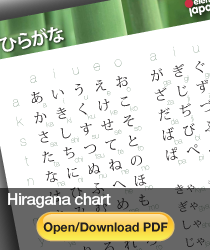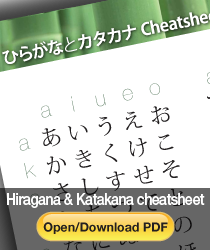Hiragana PDF Downloads
Hiragana Chart (PDF)
Hirgana also available in PNG format: Japanese Hiragana chart (PNG)
Hiragana and Katakana Cheatsheet
This one will be especially useful when you have learned Hiragana and Katakana but you sometimes forget a character or two.
This Hiragana and Katakana chart (or you could say Kana chart) is also available in PNG image format: Japanese Hiragana and Katakana chart (PNG)
Hiragana
Japanese Hiragana is one of the two syllabic alphabets (the other one is Katakana) that Japanese uses and is one of the easier scripts to learn.
Usage of Hiragana in modern Japanese
Hiragana is the first writing system Japanese kids learn at school and you should definitely master it even before starting to learn your first Japanese words.
Hiragana is used to
- write Japanese words for which there is no Kanji (Chinese character/s),
- write down words for which the Kanji is obscure (with complicated Kanji it often happens that only highly educated people know how to write them, although a wider publicity will know hot read them so they can type it on a computer interjections and onomatopoeia are often written in Hiragana as well
- write grammatical endings of verbs and adjectives (here hiragana can be referred to as okurigana), example: 歩く(あるく)to walk, where the く is okurigana
- sometimes when you include a complicated or not really common Kanji in your writing, you might want to include pronunciation above the Kanji (when writing from left to write in lines) or to the left of the Kanji in question (when writing in columns).
Hiragana Spelling Rules
- One character symbolizes one syllable (in Japanese "n" can be a syllable by itself). A syllable can be a separate vowel (a,i,u,e,o) or a combination of a consonant + a vowel, such as ka, so, yu.
- when there's a long woven, it's usually written as two following vowels: ああ、ええ、いい、うう.
The long "o" sound is usually written as "おう" and the long "e" sound is very often written as えい
Examples:
えいが ēga (映画)movie
おおきい ōkī (大きい)big: おお(oo)> ō
どうぞ dōzo: お+う > ū
Long vowels can be also written as a syllable + a vowel, where the vowel in the syllable was the same vowel or a syllable ending in o sound + う or a syllable ending in the e sound + い:
おおきい ōkī –> き+い(ki+i) > kī - small つ as in あっと(atto) after symbolizes that the following consonant is doubled, which is usually realized by holding the breath for a moment before pronouncing the following consonant:
すって(吸って)smoke (re-form of to smoke): pronounced su'te / sutte, where you take a short break before pronouncing the "tte"
Hiragana character order
In traditional Japanese writing, characters are written in columns from right to left. The traditional Hirgana chart has columns of different rows (a, ka, sa, ta, na ha, ma ya, ra, wa, and n) and there are always five characters in each row (or here column, to be exact, but they're called rows as a grammatical term) one with each of the five (terminal) vowels, in traditional order a, i, u, e, o:
Often you'll also see Japanese text written in the Western way, i.e., in lines from left to right. Then you will often see Hiragana organized in lines of five characters each (with sounds ending a, i, u, e, o) and each row represents one grammatical row (a, ka, sa, ta, na, ha, ma, ya, ra, wa, and then the lonely n)
